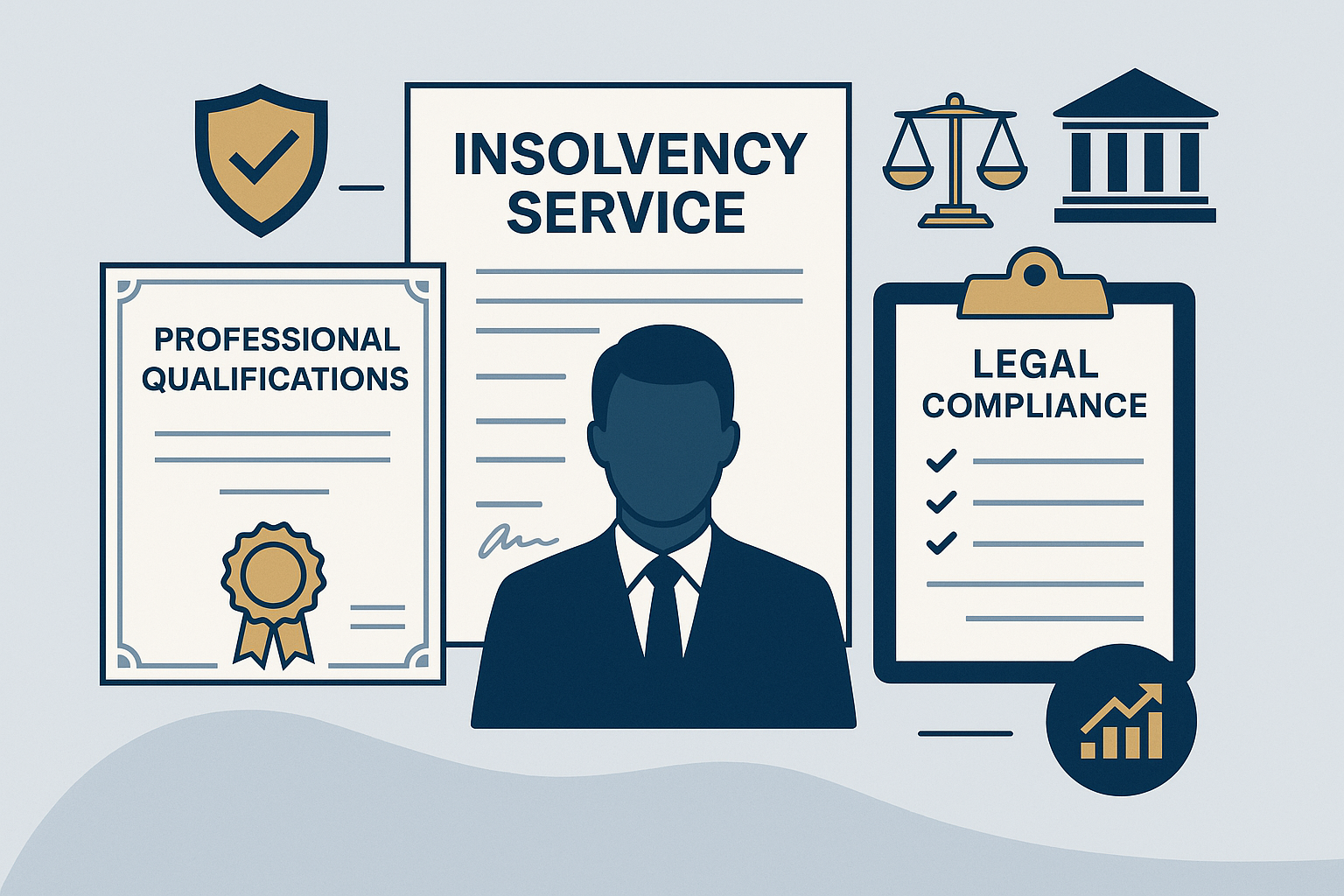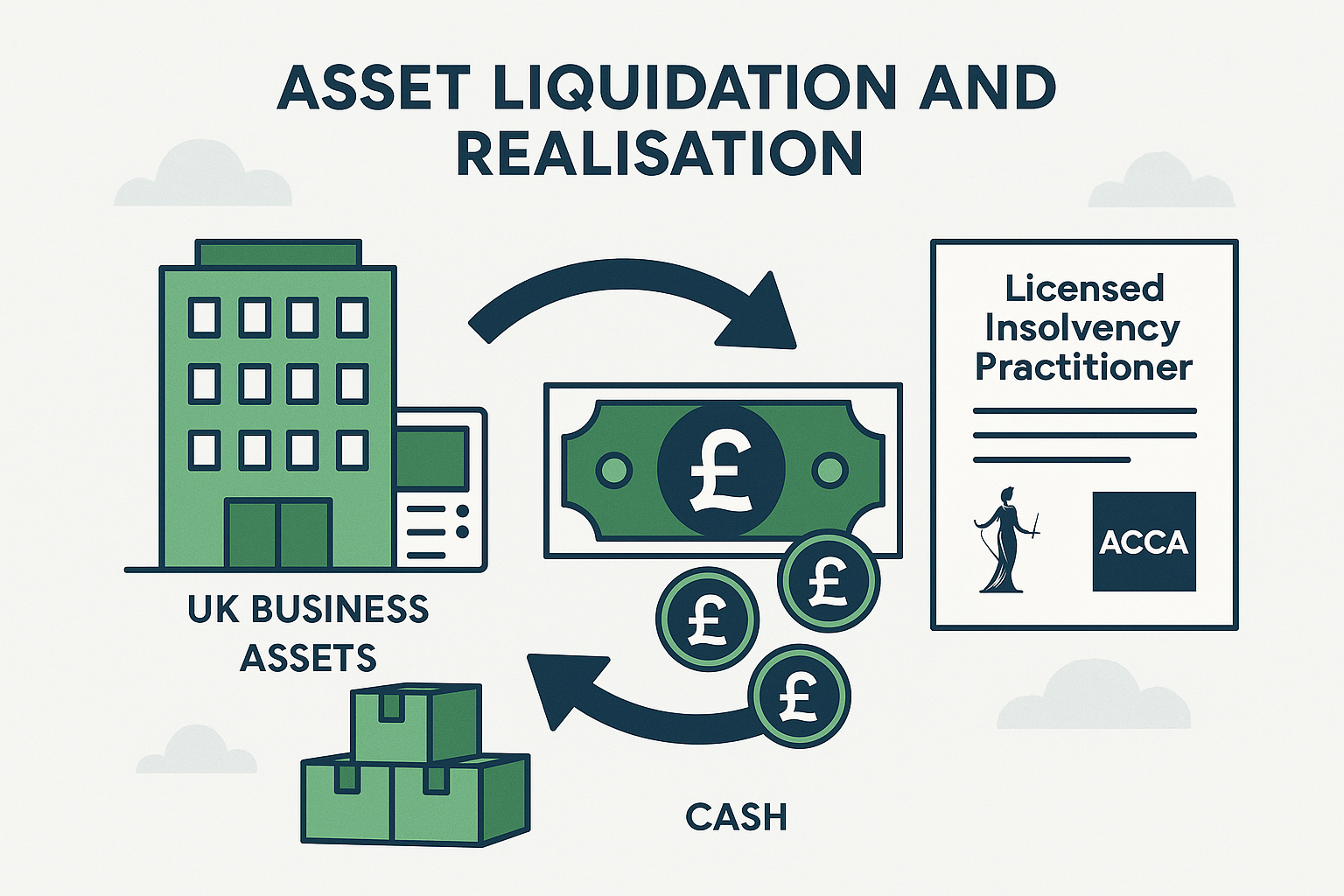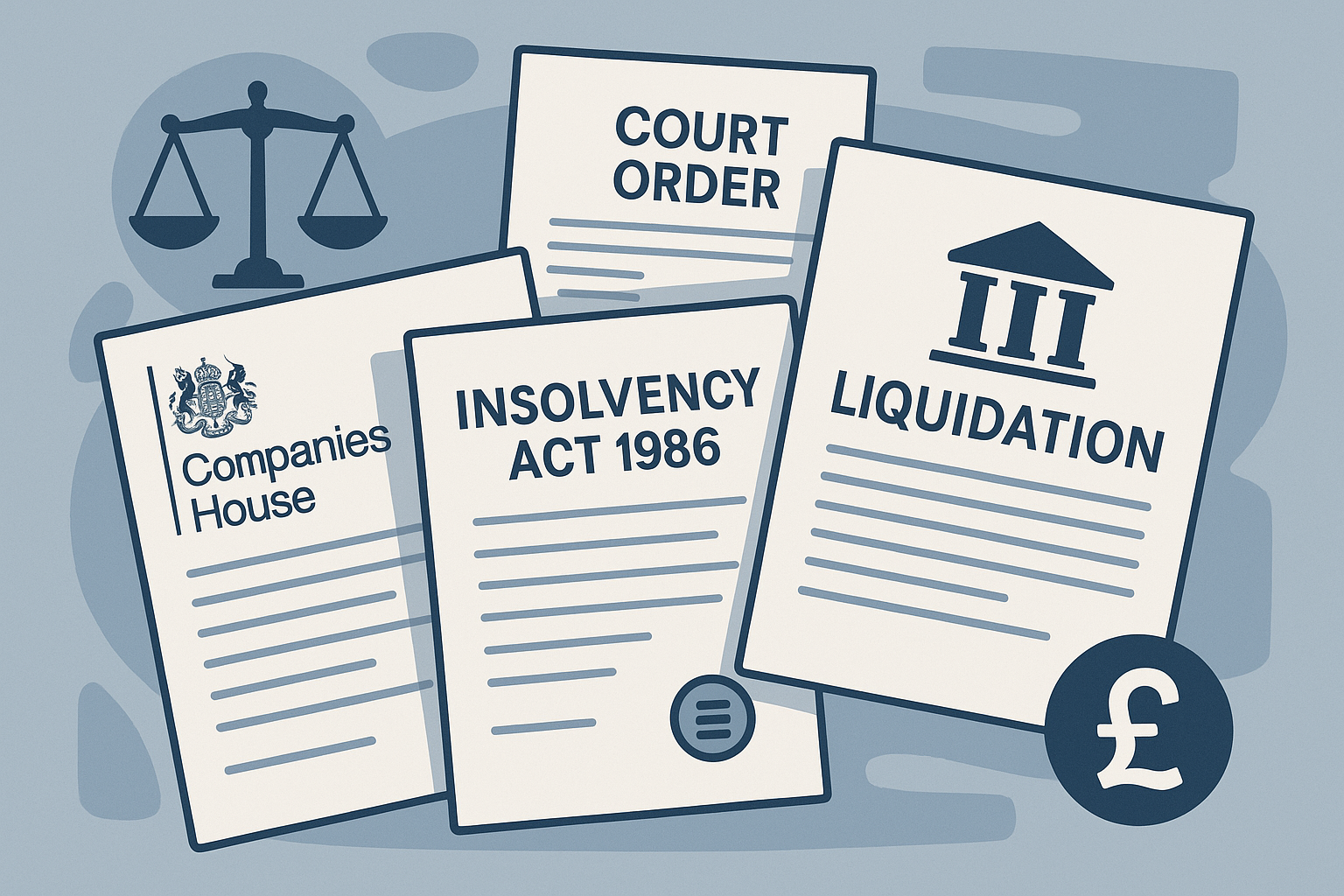What Happens When You Hire an Insolvency Practitioner Many UK directors and business owners face stressful financial problems—ranging from mounting debts to the risk of compulsory liquidation. When these challenges surface, seeking professional support can be the turning point. Hiring an insolvency practitioner UK for your company brings legal protection, business rescue opportunities in the […]
What Are the Different Types of Liquidation, and How Do They Work?
A comprehensive guide to UK liquidation procedures under English law, including voluntary and compulsory liquidation processes, legal implications, and alternatives for businesses facing financial difficulties. Liquidation represents a critical cessation process for companies operating under English law, manifesting in several distinct forms under the regulatory framework established by the Insolvency Act 1986 and Companies Act 2006. Voluntary liquidation encompasses Members' Voluntary Liquidation (MVL) for solvent entities and Creditors' Voluntary Liquidation (CVL) for insolvent companies, initiated by shareholders or directors under statutory provisions. Compulsory liquidation arises through court intervention under the High Court or County Court system, typically prompted by creditor petitions under Section 124 of the Insolvency Act 1986. Understanding these procedures allows stakeholders to navigate the complexities associated with each scenario whilst ensuring compliance with UK insolvency legislation. Liquidation under UK insolvency law represents a critical process for dissolving a company operating under English law, manifesting in several distinct forms, each governed by specific statutory procedures and regulatory implications established by the Insolvency Act 1986 and Companies Act 2006. Voluntary liquidation occurs when shareholders of a company decide to cease operations under the provisions of English law, whilst compulsory liquidation is initiated by creditors through court orders against companies that cannot pay their debts under the statutory tests established by Section 123 of the Insolvency Act 1986. Creditors' Voluntary Liquidation (CVL) specifically allows creditors to play a significant role in the liquidation process under UK insolvency legislation, enabling them to influence the appointment of licensed insolvency practitioners and mitigate potential losses through structured asset realisation. When a company operating under English law chooses to cease operations, voluntary liquidation often becomes a strategic option available under the regulatory framework established by the Insolvency Act 1986 and Companies Act 2006. Voluntary liquidation under UK insolvency law is categorised primarily into two distinct types: creditors' voluntary liquidation and members' voluntary liquidation, each serving different company circumstances and operating under specific statutory provisions. Creditors' voluntary liquidation occurs when an insolvent company resolves to liquidate its assets under Section 84 of the Insolvency Act 1986 because it cannot meet its financial obligations under the cash flow or balance sheet tests established by Section 123. The company's creditors are involved in this liquidation process under statutory provisions, and a licensed insolvency practitioner regulated by professional bodies including ICAEW, ACCA, or IPA is appointed to oversee the dissolution of the company's affairs. Conversely, members' voluntary liquidation is initiated by solvent companies whose directors declare under Section 89 of the Insolvency Act 1986 the company's ability to pay all debts in full within 12 months. This process allows the company to distribute remaining assets among its members after settling all obligations under the provisions of English law, effectively bringing the company's operations to a close whilst ensuring compliance with statutory requirements. While voluntary liquidation occurs at the behest of a company's members or creditors under the provisions of the Insolvency Act 1986, compulsory liquidation is initiated by a court order under Section 124 when a company fails to pay its debts according to the statutory tests established by English law. Compulsory liquidation occurs when a creditor files a winding-up petition with the High Court or appropriate County Court alleging that the company cannot meet its financial obligations under Section 123 of the Insolvency Act 1986. The court then typically issues a winding-up order under statutory provisions, marking the formal start of the compulsory liquidation process. At this stage under UK insolvency law, the Official Receiver from the Insolvency Service is appointed to oversee the initial proceedings, though they may subsequently appoint a licensed insolvency practitioner to handle asset realisation. The role of the company's directors shifts from controlling the company to assisting in the liquidation process under their enhanced duties established by English law. The Official Receiver or appointed liquidator ensures that the company's assets are liquidated in an orderly manner under statutory provisions, maximising returns to creditors according to the hierarchy established by the Insolvency Act 1986 and ensuring compliance with legal frameworks. Creditors' Voluntary Liquidation (CVL) represents a significant method within the spectrum of liquidation procedures under UK insolvency law, distinct from compulsory liquidation and operating under the regulatory framework established by the Insolvency Act 1986. It is initiated by the directors of a company under Section 84 when they resolve that the company cannot continue due to its financial difficulties. The process is designed to allow an orderly winding up under English law, driven by the company's insolvency under the cash flow or balance sheet tests established by Section 123, where the company fails to meet its financial obligations to creditors whilst ensuring compliance with statutory requirements. Initiation: By company directors under Section 84 after concluding the company's unsustainable debt levels Creditor Involvement: In approving the liquidation process and influencing liquidator choice Licensed Insolvency Practitioner Control: Over asset realisation under statutory powers Equitable Distribution: Of funds among creditors according to the statutory hierarchy The liquidation process under UK insolvency law encompasses several key steps designed to dissolve a company's legal existence in an orderly fashion whilst ensuring compliance with statutory requirements established by the Insolvency Act 1986 and Companies Act 2006. It involves significant legal and financial implications under English law that must be addressed to safeguard the interests of creditors and shareholders whilst ensuring compliance with regulatory frameworks including reporting to Companies House and The Gazette publication requirements. During this process under UK insolvency legislation, the company's assets are methodically distributed according to statutory priorities established by the Insolvency Act 1986, ensuring secured creditors, preferential creditors including HMRC for certain taxes, and unsecured creditors receive appropriate treatment. Several critical steps must be followed in the process of liquidation under UK insolvency law to ensure it is conducted efficiently and in accordance with legal requirements established by the Insolvency Act 1986: Understanding the legal and financial implications of liquidation under UK insolvency law is crucial for stakeholders involved in or affected by this process operating under the regulatory framework established by English legislation. Company liquidation is initiated through a formal legal process under the Insolvency Act 1986, often triggered by insolvency proceedings when companies cannot meet the statutory tests established by Section 123. This process places significant financial challenges on the company's shareholders under English law, who may face losses and potential wrongful trading accusations under Section 214. Financially, stakeholders must navigate Capital Gains Tax implications under HMRC regulations and might benefit from Business Asset Disposal Relief under UK tax legislation. Given the complexities before liquidation begins under English law, it is essential to seek professional advice from licensed insolvency practitioners to navigate these intricacies effectively. When a company is placed into liquidation under English law, whether through voluntary liquidation under Section 84 or compulsory liquidation under Section 124, the handling of the company's assets follows a structured protocol established by statutory provisions: This section evaluates liquidation under UK insolvency law in comparison with other mechanisms of business termination available under English legislation, such as administration under Schedule B1 of the Insolvency Act 1986 and dissolution under the Companies Act 2006. Each closure option presents unique consequences for the stakeholders involved under UK legislation and the future viability of the business entity, requiring careful consideration of legal, financial, and commercial factors. While liquidation and administration are both procedures related to business distress under UK insolvency law, dissolution represents another distinct method of concluding a company's activities under the regulatory framework established by the Companies Act 2006. Dissolution involves legally ending the existence of a company under statutory provisions, typically after all its affairs have been settled through liquidation. In liquidation under UK insolvency law, whether the company is solvent or insolvent dictates the approach, primarily aiming to wind up the company by distributing assets according to statutory hierarchy. A company's ability to recover post-liquidation under UK insolvency law is fundamentally constrained, as liquidation typically signifies the terminal phase of a company's existence under English law, wherein assets are sold to satisfy creditors and the company's legal personality is extinguished. Recovery post-liquidation is generally implausible under English law due to the finality of court orders, dissolution of company assets, termination of directors' roles, and the nature of liquidation procedures under the Insolvency Act 1986. A company operating under English law may enter liquidation due to various signs of insolvency under the statutory tests established by Section 123 of the Insolvency Act 1986, which impede its ability to meet financial obligations to creditors. Understanding the factors that lead to such financial distress under the regulatory framework is essential in evaluating the viability of liquidation as a strategic response whilst considering alternatives such as administration or Company Voluntary Arrangements. Signs of insolvency under UK insolvency law can serve as early warnings that a company may be heading towards liquidation: Several factors can precipitate insolvency proceedings under UK insolvency law, ultimately leading a company towards liquidation under the regulatory framework established by the Insolvency Act 1986. Compulsory liquidation occurs when creditors petition the court under Section 124 due to unpaid debts exceeding £750 under statutory demand procedures. Creditors' voluntary liquidation arises when poor cash flow or untenable debt levels prompt stakeholders to agree that liquidation under Section 84 is the best course to mitigate further losses. In the context of liquidation under UK insolvency law, creditors play a pivotal role through legal action and statutory rights in the assertion of their claims against the insolvent entity under the regulatory framework established by the Insolvency Act 1986. The appointment of a liquidator under statutory provisions marks a critical juncture, as this licensed insolvency practitioner is responsible for the equitable distribution of the company's assets according to the hierarchy established by English law. Creditors play a pivotal role in the liquidation process under UK insolvency law, primarily concerned with the recovery of debts owed to them whilst ensuring compliance with statutory procedures: CVL Initiation: Under Section 84 with creditor involvement in liquidator appointment Deemed Consent: Procedures under statutory provisions to reduce delays Investigation Requests: For suspected misconduct or wrongful trading Valuable Insights: During creditor meetings to influence asset disposal decisions A liquidator assumes a critical role during the liquidation process under UK insolvency law, tasked with the orderly winding up of a company's affairs whilst ensuring compliance with statutory requirements established by the Insolvency Act 1986. The liquidator assesses the company's assets and determines the best way to liquidate them to maximise returns for creditors according to the hierarchy established by the Insolvency Act 1986, ensuring professional oversight and regulatory compliance throughout the process. To mitigate the risk of liquidation under UK insolvency law, businesses must explore viable alternatives and implement robust financial planning strategies whilst ensuring compliance with director duties established by the Companies Act 2006 and Insolvency Act 1986. Investigating options such as restructuring debts through Company Voluntary Arrangements, seeking new investments, or negotiating with creditors can provide pathways to financial stability without resorting to liquidation. Several effective strategies can preempt liquidation whilst ensuring compliance with statutory requirements: Exploring alternatives to liquidation under UK insolvency law is essential for businesses seeking to avoid dissolution: Effective financial planning under UK legislation serves as a critical tool in averting the need for liquidation by providing businesses with a roadmap to manage their liabilities whilst ensuring compliance with director duties: Risk Analysis and Management: Evaluating potential financial risks under the regulatory framework Cash Flow Monitoring: Regular monitoring to prevent liquidity crises Strategic Asset Management: Optimising asset use under the Companies Act 2006 Stakeholder Communication: Transparent communication with shareholders and creditors To summarise, the various facets of liquidation under UK insolvency law delineate a complex yet structured process, indispensable in scenarios of financial distress whilst ensuring compliance with statutory requirements established by the Insolvency Act 1986 and Companies Act 2006. Companies must navigate through orderly dissolution under professional oversight or face compulsory liquidation through court intervention, implicating significant roles for creditors and stringent legal oversight from the Insolvency Service. Understanding these mechanisms under UK insolvency legislation and exploring viable alternatives is critical for management aiming to circumvent the detrimental impacts of liquidation whilst ensuring compliance with director duties, thereby preserving value and stakeholder interests in the precarious juncture of business closure under English legislation. Key Takeaways

What Are the Different Types of Liquidation?
Exploring Voluntary Liquidation
Understanding Compulsory Liquidation

The Role of Creditors' Voluntary Liquidation (CVL)
Key Elements of CVL under UK Insolvency Legislation:
Understanding the Liquidation Process
What Are the Key Steps in Liquidation?
Step
Description
Legal Framework
Initiation
Statutory declaration under Section 89 for MVL or resolutions under Section 84 for CVL
Insolvency Act 1986
Appointment of Liquidator
Official Receiver or licensed insolvency practitioner takes charge
Professional oversight and statutory powers
Asset Liquidation
Methodical asset sale to repay creditors according to statutory hierarchy
Insolvency Act 1986 priorities
Dissolution
Formal dissolution through Companies House procedures
Companies Act 2006
What Are the Legal and Financial Implications of Liquidation?
Important Financial Considerations:
What Happens to a Company's Assets During Liquidation?
Liquidation vs. Other Business Closure Options
How Does Liquidation Compare to Administration?
Aspect
Liquidation
Administration
Purpose
Formal cessation of operations and asset distribution
Rescue company as going concern or achieve better creditor outcomes
Initiation
Directors (Section 84) or court order (Section 124)
Directors, creditors, or court appointment under Schedule B1
Outcome
Wind down company affairs and distribute assets
Recovery through restructuring or transition to liquidation
Control
Licensed insolvency practitioner as liquidator
Administrator under statutory purposes
What Is the Difference Between Dissolution and Liquidation?
Can a Company Recover After Liquidation?

Why Might a Company's Affairs Lead to Liquidation?
Signs a Company Is Insolvent
Key Insolvency Indicators:
Factors Leading to Insolvency Proceedings
How Are Creditors Involved in Liquidation?
Understanding Creditors' Rights
Key Aspects of Creditor Involvement:
The Function of a Liquidator
Preventing Liquidation: Alternatives and Strategies
How Can Businesses Avoid Liquidation?
What Are the Alternatives to Liquidation?
Alternative
Legal Framework
Suitable For
Creditors' Voluntary Liquidation
Section 84 Insolvency Act 1986
Insolvent companies
Members' Voluntary Liquidation
Section 89 Insolvency Act 1986
Solvent companies
Administration
Schedule B1 Insolvency Act 1986
Companies requiring rescue or restructuring
Company Voluntary Arrangement
Part I Insolvency Act 1986
Companies seeking creditor agreements
How Can Financial Planning Help Prevent Liquidation?
Key Financial Planning Strategies:
Conclusion
How Are Insolvency Practitioners Appointed – UK Expert Guide Navigating financial turmoil can be overwhelming for company directors and sole traders alike. Faced with mounting debts, threats of compulsory liquidation, or creditor demands, knowing “how insolvency practitioners are appointed” becomes crucial for preserving your organisation. In the UK, professional insolvency services, such as company voluntary […]
Administration might be your lifeline when your company's drowning in debt and creditors are circling. But here's what most directors don't understand: it's not just about buying time — it's about buying the right kind of time, with the proper professional support. The difference between administration working for you or against you often comes down […]
Can an Insolvency Practitioner Stop Creditors? In the UK, mounting pressure from creditors can disrupt cash flow, increase stress for directors, and push a company toward insolvency. Professional guidance plays a pivotal role in countering these challenges. Nexus Corporate Solutions Limited specialises in helping businesses find relief from persistent creditors, providing strategic solutions that align […]
When your company's in financial trouble, one of the biggest worries is what happens to everything you've built. Your equipment, property, stock — the assets that represent years of hard work. It's a valid concern, and you're not alone. The reality? How insolvency practitioners handle your company's assets can make or break the outcome for […]
Insolvent trading can trigger severe repercussions for UK directors, including personal liability and possible disqualification. When a business is unable to pay debts and continues to trade without a reasonable prospect of avoiding insolvency, the law may classify this as wrongful trading. The Insolvency Act 1986, alongside related legislation, outlines civil and criminal penalties for […]
Recognising the signs of business insolvency early is vital for UK companies. Overlooked warning signals—such as recurring cash flow issues, unpaid HMRC tax arrears, or missed staff wages—can quickly escalate into serious risks that demand immediate attention. Being aware of these common signs of business insolvency enables directors to take timely action, whether through careful […]
Supplier insolvency can have serious consequences for UK companies, creating ripple effects that extend beyond the affected supplier. Cash flow interruptions, delayed payments, and increased operational risks are common outcomes. When a key supplier or client becomes insolvent, contracts may be disrupted, insurance coverage can be affected, and overall profitability may decline. Nexus Corporate Solutions […]
Struggling with IVA monthly payments can feel overwhelming, especially when daily financial obligations pile up. An Individual Voluntary Arrangement (IVA) is designed to help those in debt regain stability by consolidating and managing repayments under a legally binding agreement. However, life changes—like reduced monthly income, sudden expenses, or shifts in personal circumstances—often make sticking to […]
Experiencing financial difficulty can make everyday life more challenging, especially when an individual or business director needs to secure a stable living arrangement. In the UK, an Individual Voluntary Arrangement (IVA) offers a legally binding debt solution that eases pressure from creditors. However, many worry about problems renting after IVA. Questions about how this might […]

Address: Apex Building, 1 Water Vole Way, Balby, Doncaster, South Yorkshire, DN4 5JP
Tel: 01302 430180
Services
Company


